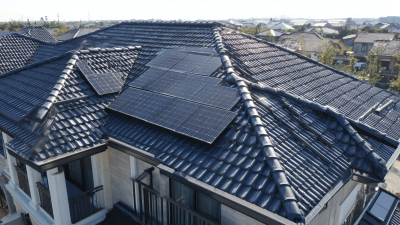Understanding Issues with pv tiles in Modern Construction
As the construction industry increasingly seeks sustainable and energy-efficient solutions, the integration of photovoltaic (PV) tiles has gained significant attention. According to a report by the International Energy Agency (IEA), global solar energy capacity reached 1,000 GW in 2020, with building-integrated photovoltaics (BIPV), including PV tiles, playing a crucial role in this expansion. However, despite their potential, many projects encounter persistent issues related to installation, energy efficiency, and material performance.

A recent study published in the Journal of Building Physics highlights that over 30% of PV tile installations fail to meet expected energy output due to inadequate design and installation practices. This blog will explore the common challenges faced by industry professionals when incorporating PV tiles into modern construction, providing insights and examples to help navigate these complexities effectively.
Common Challenges Faced with PV Tiles in Modern Building Designs
Photovoltaic (PV) tiles have garnered attention as an innovative solution in modern construction, promising both aesthetic appeal and energy efficiency. However, various challenges have emerged in their implementation within building designs. According to a report by the International Energy Agency, the adoption rate of building-integrated photovoltaics (BIPV), which includes PV tiles, is projected to reach only 6% of the global solar market by 2025. This slow uptake is often attributed to high initial costs and the complexities involved in installation.
One common issue is the compatibility of PV tiles with existing building materials and architectural styles. A study conducted by the National Renewable Energy Laboratory highlighted that poor integration can lead to significant thermal insulation problems, affecting building performance. Furthermore, maintenance concerns arise, as some PV tiles are more difficult to clean and repair than traditional solar panels. With an estimated maintenance cost increasing to 15% of the overall investment over their lifespan, builders and homeowners alike must weigh these challenges against the long-term benefits of solar energy harvesting.
Technical Limitations: Voltage, Efficiency, and Performance of PV Tiles
The deployment of photovoltaic (PV) tiles in modern construction presents numerous technical challenges tied to voltage, efficiency, and overall performance. As solar technology continues to evolve, developers must address the inherent limitations of these tiles, particularly regarding energy output under varying environmental conditions. For instance, solar irradiance, ambient temperature, and atmospheric conditions significantly influence PV tile performance. These factors necessitate comprehensive design strategies to mitigate energy loss and enhance efficiency.
Moreover, advancements in recycling technologies for silicon-based PV panels highlight the need for sustainable waste management as the popularity of solar energy surges. Addressing the lifecycle of PV tiles—from installation through to end-of-life—demands innovative approaches to recover valuable resources.
Recent research into maximum power point tracking for solar charge controllers underlines the importance of optimizing energy capture in fluctuating conditions. This optimization is critical not only for ensuring high energy yields but also for promoting the longevity of PV tiles, contributing to a more sustainable construction paradigm.
Cost Analysis: Weighing Benefits Against Initial Investment for PV Tiles
The integration of photovoltaic (PV) tiles into modern construction is a promising advancement, yet it raises critical questions regarding cost versus benefits. According to a report from the U.S. Department of Energy, the average installation cost for solar photovoltaic systems has dropped significantly, now averaging around $3 per watt. However, when considering PV tiles, the initial investment can vary greatly, ranging from $15,000 to $25,000 for a typical residential roof, which may deter potential buyers. Understanding these costs in relation to long-term energy savings is paramount for homeowners and builders alike.
One of the primary benefits of PV tiles is their aesthetic appeal, seamlessly blending with traditional roofing materials. In fact, a study from the Lawrence Berkeley National Laboratory indicates that homes equipped with solar roofs can increase property values by up to 17%. Homeowners should consider financing options such as solar loans or leases that can mitigate upfront costs while still allowing them to enjoy the advantages of renewable energy.
Tip: Always conduct a comprehensive financial analysis, factoring in potential savings on energy bills and tax incentives. Additionally, consult with a professional installer to assess the specific long-term benefits tailored to your location and energy usage. By evaluating these elements, you can make an informed decision that aligns with your financial goals while promoting sustainability in construction.
Maintenance and Durability: Ensuring Longevity of PV Tile Installations
The maintenance and durability of photovoltaic (PV) tiles are critical factors that influence their effectiveness and longevity in modern construction. Unlike traditional solar panels, PV tiles serve a dual purpose: they not only generate renewable energy but also act as roofing materials. This integrated approach can lead to unique challenges, particularly when it comes to their upkeep. Regular inspections are essential to identify potential issues such as cracks, debris accumulation, or water infiltration, which can compromise their performance and shorten their lifespan.
To ensure the longevity of PV tile installations, selecting high-quality materials and employing skilled installers is paramount. Manufacturers often provide guidelines on maintenance procedures, which include cleaning the tiles to enhance efficiency, monitoring for any signs of wear and tear, and promptly addressing any repairs. Furthermore, understanding the specific climate conditions in which the installation occurs can aid in determining the frequency and type of maintenance required. Proper care not only maximizes the energy output of PV tiles but also contributes to the overall sustainability goals of modern buildings, reinforcing the importance of maintenance in the lifespan of these innovative installations.
Maintenance and Durability of PV Tiles in Modern Construction
Regulatory and Compliance Issues: Navigating Legalities in PV Tile Use
The use of photovoltaic (PV) tiles in modern construction brings forth a myriad of regulatory and compliance issues that businesses and individuals must navigate carefully. As the construction industry increasingly embraces renewable energy solutions, understanding the legal framework surrounding PV tile installations becomes vital. Various jurisdictions impose different standards for energy efficiency, safety, and sustainability that can affect project timelines and costs. These legalities often require thorough documentation and adherence to specific building codes, which can complicate the integration of PV tiles into green building projects.
Moreover, the evolving landscape of regulations means that businesses need to stay updated on compliance requirements to avoid potential penalties. Mapping out the legal obligations related to PV tiles not only helps mitigate risks but also presents opportunities for developers to enhance their projects' marketability. Engaging legal expertise early in the planning process can facilitate navigating these complexities, ensuring that both corporate entities and individual homeowners can successfully implement renewable solutions while aligning with regulatory mandates.
Related Posts
-

Navigating Import and Export Certifications for the Best PV Tiles in the Global Market
-

Exploring the Revolution: What are Solar Cell Roof Tiles and Their Benefits?
-

Innovative Solutions for Harnessing Energy with Photovoltaic Tiles
-

What Makes Solar Panel Tiles a Smart Choice for Sustainable Energy Solutions
-

15 Top Reasons to Choose Best Solar PV Roof Tiles for Sustainable Energy Solutions
-

Ultimate Guide to Solar PV Battery Comparisons for Global Procurement Insights